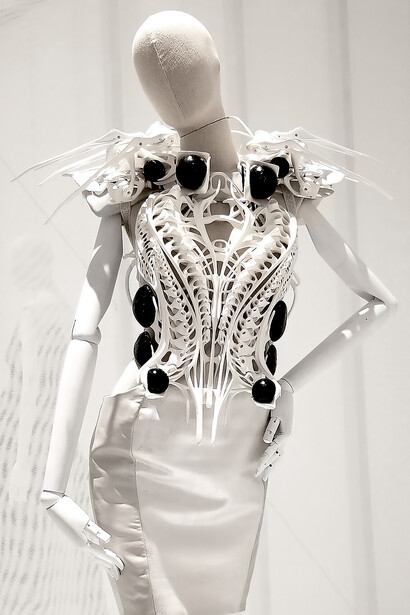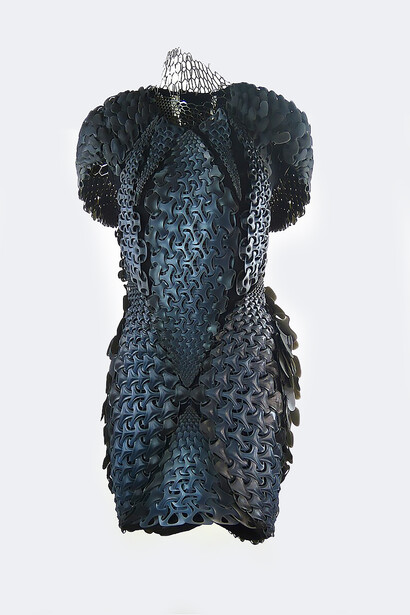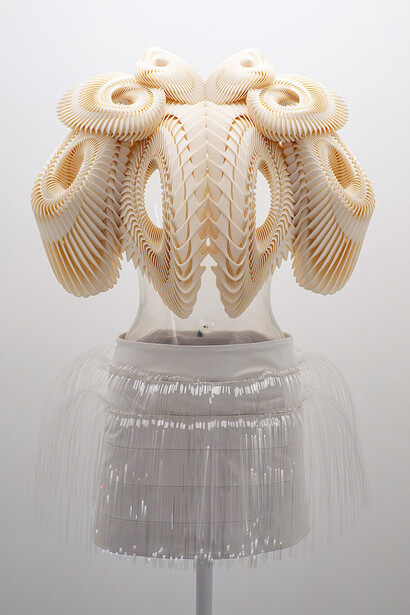The fashion industry is renowned for being innovative and culturally conscious, but at an enormous environmental cost. Conventional clothing production consumes massive amounts of water, power, and raw materials, and generates a lot of waste: it has been estimated that up to 40% of produced clothing ends up in landfills, and water use is quantified in tens of trillions of liters yearly for simple clothes. In addition, excess production and excess stock exacerbate the problem, with brands and consumers battling lost inventory and its overall sustainability. As a result, designers and technologists are turning to 3D printing (additive manufacturing) as a disruptive technology to reduce waste, enable upcycling, and explore new creative potential.
3D printing basics & waste reduction
3D printing builds objects layer by layer from a computer model, with only the minimum quantity of material necessary for the end product being used. Unlike traditional cut-and-sew processes, which generate huge fabric offcuts, additive manufacturing can eliminate—or, in ideal circumstances, eliminate—material waste because it prints only the geometry required. In industries like footwear, this benefit has been quantified: a print-to-textile additive process can reduce nearly 25% of CO₂e emissions compared to conventional methods, save up to 50% of stock material, and reduce water usage considerably with fewer processing stages. Such savings are crucial in an era where consumers and policymakers demand greener production.
Besides, the "on-demand" model facilitated by 3D printing supports short-run manufacture and personalisation without overstocking for companies. Small-batch printing at a localised level can also reduce transportation emissions and storage costs, supporting the circular economy. Industrial-scale adoption is currently under development, but pilot projects in footwear and accessories show that additive workflows can be integrated into existing supply chains, with improving environmental burdens over time.
Upcycling & new sustainable materials
Along with minimizing waste in new production, 3D printing makes upcycling possible: transforming post-consumer or industrial waste into printable feedstock. Used PET bottles, for example, can be processed into filament suitable for print, converting disposable plastics into fashion accessories like buckles, buttons, or even parts of garments. Biodegradable and bio-based filaments—such as algae polymers—that are easier to biodegrade at the end of their life are also being developed and explored by startups, minimizing the footprint further.
Startups like Simplifyber offer another take: they 3D-print moldings and cast biodegradable cellulose-based slurries to create fabric-like pieces with reduced waste, no spinning and weaving processes. These innovations illustrate how new chemistries can be integrated with additive techniques to redefine garment design. Labels like ZER Collection in Spain also use 3D-printed elements in urban wear, using recycled materials to accelerate production and minimize waste streams.
Creative freedom & personalisation
Additive manufacturing releases designers from the limitations of flat patterns. Complicated geometries—lattice structures, organic shapes, interlocking modules—can be achieved without tedious manual assembly. It allows modular garments that can be deconstructed, repaired, or recombined, extending the lifetimes of products. Custom-fit printing based on body scans facilitates inclusive sizing and minimizes returns. Future studies also explore 4D printing (shape-memory materials) and embedded electronics, pointing towards garments that adapt to needs or states of the environment.
High-fashion designers have shown these possibilities. Dutch fashion designer Iris van Herpen debuted one of the earliest 3D-printed haute couture creations at Paris Haute Couture in 2010, employing selective laser sintering to develop sculptural nylon forms that defy traditional sewing. Her designs both reveal the possible aesthetics and the technical hurdle: prototypes initially were rigid and more suited for exhibition than daily use, but they opened the door to ongoing R&D on flexible polymers and hybrid structures. Similarly, Noa Raviv of Israel teamed with Stratasys to exhibit 3D-printed designs in the "Manus x Machina" show at the Metropolitan Museum of Art in 2016, mixing printed shapes with hand-stitched textiles in an exploration of machine and craft.
Influencer spotlight: Maia Hirsch
While most of the 3D-printed fashion evidence comes from veteran haute couture, fresh voices fill the space between tech and aesthetics. Venezuelan wearable-tech designer and engineer Maia Hirsch explores interactive fashion and accessories that integrate robotics, haptics, and fabrication technology. Though much of her work revolves around functional wearables—haptic vests and responsive dresses, for example—her research shows the type of innovative, sustainable innovations engineering viewpoints can enable. By experimenting with light, modular systems, and also considering the recyclability of electronic components and 3D-printed items, Hirsch's designs point towards futures where customized, technology-enabled clothing will also include circular design thinking.
Local initiative: Berlin's 3D-Eco-fashion
In Berlin, non-profit initiative Mittel- und Osteuropa (InMOE) is spreading a people-driven initiative with its Erasmus+-supported 3D-ECO-Fashion course. The course teaches young designers 3D modeling and printing and circular-fashion methods, such as how to design repairable and modular items and use recycled materials. By organizing workshops and site visits, they allow students to prototype sustainable clothing in Prenzlauer Berg's Makerspace out of local materials.
A highlight of the program is the InMOO Fashion Show 2025 in September 2025 in Berlin, where course graduates will present 3D-printed fashion. The event will illustrate tangible results from combining technology and sustainability and stimulate discussion on scaling circular practices into the wider industry.
Global & industry context
With the exception of individual designers and NGOs, larger companies and research institutes are looking into additive solutions. Footwear titans have experimented with custom 3D-printed midsoles; textile labs analyze printed garments with little external support structures; materials researchers develop recyclable composites. Studies proved that additive manufacturing can reduce emissions, energy usage, and waste by orders of magnitude in certain stages of production, though lifecycle analyses are context-dependent. Cross-disciplinary working—fashion, engineering, materials science—is key to addressing current challenges.
Challenges & outlook
Promising, but with several challenges to overcome:
Material performance: Most polymers 3D-printed today are not elastic, breathable, or strong enough for everyday wear. Advances in elastomeric resins, composite filaments, and hybrid assemblies are ongoing, but large-scale production hinges on discovering materials with optimal comfort, aesthetics, and sustainability.
Cost & accessibility: High-resolution industrial-grade printers and eco-friendly filament formulations can be expensive. Democratization of access relies on hardware cost decreases and open-source sharing of designs and best practices.
Post-processing & recycling: Most printed components need finishing (sanding, dyeing, assembly). Closing the loops by effectively recycling failed prints or end-of-life products, and building local recycling streams matters.
Standards & certification: As new materials emerge, safety testing (e.g., skin exposure), durability, and actual environmental benefits need thorough testing and transparent reporting.
But the pace of change is rapid: polymer chemists spin bio-based filaments; universities construct proof-of-concept shape-memory fabrics; communities work together on open-design repositories; NGOs arrange hands-on workshops. As the projects scale up, 3D printing can transition from demo samples to complete parts of sustainable supply chains.
Weaving a greener loom
Additive manufacturing and circular design together offer a multi-dimensional path towards reducing fashion's environmental footprint. By applying precise, on-demand manufacturing, recycling end-of-life streams into printable material, and developing new biodegradable or bio-based materials, designers can create clothing that is both innovative and sustainable. Creative ventures—like Berlin's 3D-ECO-Fashion workshops or global runway tests by Iris van Herpen and Noa Raviv—demonstrate that technology and creativity can be combined to bridge the mindset of disposability.
Emerging stars like Maia Hirsch demonstrate how engineering mentality can turn fashion into interactive, customized, and potentially more sustainable experiences. To reach that future, designers must collaborate with technologists, material scientists, NGOs, and policymakers. Enabling hands-on training, open innovation platforms, and lifecycle studies will overcome the existing barriers.
Tomorrow's fashion isn't merely about what we wear, but about how we create, produce, and regenerate it. With each layer of print, we take a step toward a circular, digitally powered industry, where fashion intersects sustainability in each filament and thread.















